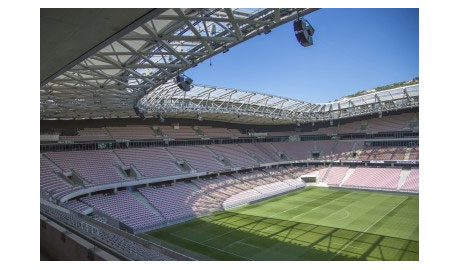 |
| In terms of sound quality and intelligibility, the most important factors are the selection of the loudspeakers, their location, and how they can best be hung and configured to provide even coverage throughout the venue |
Stu Schatz, application engineer and Bob Rieder, regional marketing manager for Bosch/Electro-Voice North America provide insight on the increasing importance of networking and being IT literate in stadium installs.
What are the main challenges of working on stadium projects?
Time is usually the biggest challenge. It is a common situation to have multiple trades working in the same place at the same time, so you often find yourself waiting for someone else to complete their task so you can do your work. It can also be a challenge to try to make progress while other parts of the installation are going on. It’s not easy to tune a system with a pneumatic hammer in use, or a crane blocking the loudspeaker array you are working on!
What are the products that you find are most important to know about in depth in the stadium market?
For Electro-Voice, that would be loudspeakers, amplifiers and DSP. In addition, networking devices play a critical role in large venue installations. Being able to understand and speak IT is crucial these days. In terms of sound quality and intelligibility, the most important factors are the selection of the loudspeakers, their location, and how they can best be hung and configured to provide even coverage throughout the venue. This means that you really need to model and understand how multiple loudspeakers will interact to ensure that they will work together to enhance the overall sound quality and not interfere in a way that makes sound less intelligible. The goal is to deliver excellent, consistent coverage to every seat in the stadium. In the bowl area, the best solution might be multiple line arrays, carefully designed clusters, individual long-throw cabinets, or some combination of these form factors. If the loudspeaker locations are already fixed, this constraint may partially dictate what kind of loudspeaker solution you can implement, either because of weight or because of the distance to the audience area you are trying to cover.
Once the speaker layout for the bowl is complete, you can turn your attention to adequate speaker density in the public areas and higher quality reproduction in VIP areas and suites. Once the full speaker complement is known, you can then assemble an amplifier plan that will safely drive speakers to the required levels. In terms of processing, you need to create a design that will get signals to the amplifiers, wherever they are located. But, more importantly, you have to also understand the thermal and mechanical limits of the loudspeakers so that you can correctly adjust monitoring and processor settings to ensure that loudspeakers are never driven past their intended design limits.
What makes the difference between a profitable stadium project and an unprofitable one?
Planning and project management make all the difference here. Change orders, rushed orders, under-estimating labour time and re-doing any part of the project add huge costs to the project that can make the difference of the project being profitable or not. The critical factor is to communicate every aspect of the design requirements at the outset and throughout the entire process from original concept to commissioning.
| "This major installation illustrates the breadth of our high performance speaker products, we can offer consistently high sound quality throughout a venue, from ceiling speakers up to line arrays" |
Do you find new-build stadiums easier or harder to work on than older/refurbished venues?
A new-build venue is typically easier because you are starting with a clean slate, and can get electrical service, cable runs, rigging points and conduit where you need them. In a renovation project, you often have to work with and around what’s already in place, but you often face the challenge of reconciling existing infrastructure with what you are able to add to support the new system. All in all, the risk of needing to compromise the design is higher for a refurb than for new construction.
Which technologies, rather than specific products, are you seeing increased demand for in stadiums?
Networking increasingly drives a lot of the system design. But in Europe in particular, you need to support two different goals with audio design. One is the need for a sound reinforcement system for public address and music reproduction. The other is the requirement for an effective mass notification system to be used in case of emergency. In many stadiums, there are two separate systems to accomplish this. But Bosch has an initiative that we call Safe and Sound, in which we meet these two requirements with a single integrated sound system. Both our mass-notification electronics and key loudspeaker models from our Bosch and Electro-Voice lines have been certified to EN-54. This includes some of our highest quality Electro-Voice systems. So it is now possible to have a great-sounding reinforcement system that also meets the need for emergency notification.
Tell us about a recent installation project that highlights Electro-Voice’s expertise in the stadium sector.
One of the highlights of 2016 so far has been the new Miami Dolphins Stadium project. Supplying high quality sound for stadiums all over the world has always been a big part of the Electro-Voice tradition going back to our very first system, designed for football coaching legend Knut Rockne at the University of Notre Dame’s football facility over 80 years ago. For the new system in Miami, Electro-Voice products are deployed throughout the facility, with models selected to precisely address the needs of a given space. For the main system, 186 XLCi line array cabinets, 56 EVF-1122S front-load speakers, 24 EVH-1152D long-throw, horn-loaded speakers (six in each corner), and 48 custom-designed dual 18in subwoofers are used. The main arrays are integrated into custom-engineered frames designed to withstand extreme storm and wind conditions. Electro-Voice products are also used in the concourses and public areas throughout the facility, including over 1100 ZX1i and EVID speakers. Various surface-mount and ceiling models precisely serve the various spaces in which they are deployed. This all adds up to provide seamless coverage, volume and clarity for fans in all areas of the stadium. This major installation illustrates the breadth of our high performance speaker products, we can offer consistently high sound quality throughout a venue, from ceiling speakers up to line arrays.




